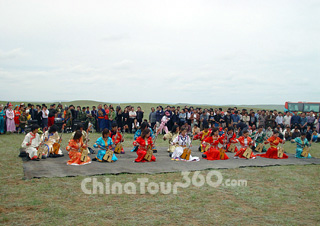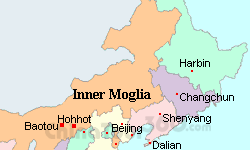 Musical Performance
Musical Performance Stone Based Mongolian Yu
Stone Based Mongolian Yu
![]() Facts
Facts
Phone Code: 0471
Postal Code: 010000
Area: 17,224 Sq km (6,650.19 Sq miles)
Population: 2,866,615 (in 2010)
Nationalities: Han, Mongolian, Hui, Manchu, Chaoxian, Daur, Russian, Bai, Li, Uigur, Zhuang, Xibe, Ewenki
Neighboring Areas: Heilongjiang, Jilin, Liaoning, Hebei, Shanxi, Shaanxi, and Gansu Provinces, Ningxia Hui Autonomous Region
Location: Situated on the Tumote Plain in the south-central area of Inner Mongolia Autonomous Region, Hohhot faces the magnificent Yellow River in the south and backs on the rolling Yinshan Mountain in the north.
![]() Physical Features: Landforms in Hohhot are mainly divided into two regions – one is the northern Daqing Mountain and southeastern Manhan Mountain; the other is the southern and southwestern Tumote Plain.
Physical Features: Landforms in Hohhot are mainly divided into two regions – one is the northern Daqing Mountain and southeastern Manhan Mountain; the other is the southern and southwestern Tumote Plain.
 |
| Hohhot Maps |
![]() History: Enjoying a history of over 400 years, Hohhot city was originally built by Altan Khan, the 17th generation of Genghis Khan, a leader of the Mongol tribe in ancient China, in 1581 during the Ming Dynasty (1368 - 1644). It was given the name Kukuhetun or 'Guihua' in the early times. Later, the city was rebuilt and renamed Guisui County in 1735 during the Qing Dynasty (1644 - 1911). Finally, it was changed into Hohhot City and made the capital city of Inner Mongolia Autonomous Region in 1954.
History: Enjoying a history of over 400 years, Hohhot city was originally built by Altan Khan, the 17th generation of Genghis Khan, a leader of the Mongol tribe in ancient China, in 1581 during the Ming Dynasty (1368 - 1644). It was given the name Kukuhetun or 'Guihua' in the early times. Later, the city was rebuilt and renamed Guisui County in 1735 during the Qing Dynasty (1644 - 1911). Finally, it was changed into Hohhot City and made the capital city of Inner Mongolia Autonomous Region in 1954.
![]() Attractions: As a well-known city in the northern frontier of China, Hohhot is covered with historical sites, religious temples and unique natural views. In addition to the colorful ethnic cultures, glamorous Mongolian songs and dances and fantastic Mongolian-style wrestling, all of them are very pleasing and a magnet to visitors. As early as in the Ming and Qing dynasties, it was named 'Zhao City' (Zhao means temple in Mongolian) by the people, since the city was crowded with temples. The well-known temples are Dazhao Temple, Xilituzhao Palace, Five-pagoda Temple and the Great Mosque. Zhaojun Tomb is famed as 'Green Tomb', for the grass on it remains green all year round. Other popular cultural sites in the city are Hongshan Culture Relics, Dayao Culture Relics and Black City Site. The Natural Scenery in Hohhot is also enchanting, including the Huitengxile Grassland known as 'Cold Plateau', Gegentala Grassland known as 'Summer Resort' and Xilamuren Grassland characterized by rolling hills and lush green grass. Besides, the Islam Style Street located at the Hui people's residential areas is a characteristic sight for visitors to enjoy the Islamic flavor.
Attractions: As a well-known city in the northern frontier of China, Hohhot is covered with historical sites, religious temples and unique natural views. In addition to the colorful ethnic cultures, glamorous Mongolian songs and dances and fantastic Mongolian-style wrestling, all of them are very pleasing and a magnet to visitors. As early as in the Ming and Qing dynasties, it was named 'Zhao City' (Zhao means temple in Mongolian) by the people, since the city was crowded with temples. The well-known temples are Dazhao Temple, Xilituzhao Palace, Five-pagoda Temple and the Great Mosque. Zhaojun Tomb is famed as 'Green Tomb', for the grass on it remains green all year round. Other popular cultural sites in the city are Hongshan Culture Relics, Dayao Culture Relics and Black City Site. The Natural Scenery in Hohhot is also enchanting, including the Huitengxile Grassland known as 'Cold Plateau', Gegentala Grassland known as 'Summer Resort' and Xilamuren Grassland characterized by rolling hills and lush green grass. Besides, the Islam Style Street located at the Hui people's residential areas is a characteristic sight for visitors to enjoy the Islamic flavor.
![]() Transportation: In recent years, transportation in Hohhot has received a rapid development - a three-dimensional transport net of inside and outside city, air and land has initially formed.
Transportation: In recent years, transportation in Hohhot has received a rapid development - a three-dimensional transport net of inside and outside city, air and land has initially formed.
![]() Air: Hohhot Baita Airport operates flights to all of the municipalities and provincial capitals in China like Beijing, Guangzhou, Shenzhe, Xian, Shanghai and Wuhan, flights to the cities within Inner Mongolia like Xilinhot, Ulanhot, Manzhouli and Hailar as well as international flights to Ulan Bator and Chita.
Air: Hohhot Baita Airport operates flights to all of the municipalities and provincial capitals in China like Beijing, Guangzhou, Shenzhe, Xian, Shanghai and Wuhan, flights to the cities within Inner Mongolia like Xilinhot, Ulanhot, Manzhouli and Hailar as well as international flights to Ulan Bator and Chita.
![]() Train: Hohhot Railway Station is situated on Beijing-Baotou Railway, having direct trains to Beijing, Chengdu, Lanzhou, Tianjin, Harbin and other big-and-medium-sized cities in China. Trains from this station also run to all of the counties and cities within Inner Mongolia. There are international trains to Ulan Bator every Wednesday and Thursday.
Train: Hohhot Railway Station is situated on Beijing-Baotou Railway, having direct trains to Beijing, Chengdu, Lanzhou, Tianjin, Harbin and other big-and-medium-sized cities in China. Trains from this station also run to all of the counties and cities within Inner Mongolia. There are international trains to Ulan Bator every Wednesday and Thursday.
![]() Bus: In additional to Hohhot Long-distance Bus Station near the railway station, there are Nanchafang Bus Station and the South Bus Station located on the Shiyangqiao Road in the southern part of the city. Dozens of buses from these stations run to the nearby towns and cities daily. Meanwhile, several bus routes between Inner Mongolia and Russia's border regions have been opened. There are over 100 public bus routes in the city, leading to all of the famous tourist attractions and major shopping centers. Additionally, two tourism special routes are specially operated for the convenience of the visitors - Bus No. 23 from the railway station to Wusutu National Forest Park and Bus No. 44 from Nanchafang Bus Station to Zhaojun Tomb.
Bus: In additional to Hohhot Long-distance Bus Station near the railway station, there are Nanchafang Bus Station and the South Bus Station located on the Shiyangqiao Road in the southern part of the city. Dozens of buses from these stations run to the nearby towns and cities daily. Meanwhile, several bus routes between Inner Mongolia and Russia's border regions have been opened. There are over 100 public bus routes in the city, leading to all of the famous tourist attractions and major shopping centers. Additionally, two tourism special routes are specially operated for the convenience of the visitors - Bus No. 23 from the railway station to Wusutu National Forest Park and Bus No. 44 from Nanchafang Bus Station to Zhaojun Tomb.
![]() Taxi: Over 4000 taxis cover all of the public places, streets and lanes of the city, serving 24 hours a day. The flag-down fare is CNY6, but only for the first 2 km (1.2 miles), so CNY1 per km more will be charged for the remaining journey.
Taxi: Over 4000 taxis cover all of the public places, streets and lanes of the city, serving 24 hours a day. The flag-down fare is CNY6, but only for the first 2 km (1.2 miles), so CNY1 per km more will be charged for the remaining journey.
![]() Weather: April to October is recommended as the best time to visit Hohhot. However, the natural scenery on the grassland comes to its peak from middle July to early September, and the annual Nadamu Fair is also held during this period of time.
Weather: April to October is recommended as the best time to visit Hohhot. However, the natural scenery on the grassland comes to its peak from middle July to early September, and the annual Nadamu Fair is also held during this period of time.
![]() Dining and Shopping
Dining and Shopping
Being the gathering place of the Mongolian ethnic minorities, food in Hohhot is mostly focused on Mongolian feature, mainly divided into white food and red food. White food refers to dairy products made from the milk of cattle, sheep, horses and camels such as milk tea, milk wine, milk curd and cheese. Red food is the collective name of meat products made from beef, mutton and the flesh of some wild animals like Roasted Whole Lamb, Roasted Mutton Cubes on Spit and Dried Meat Slices. Local snacks especially Muslim snacks are also popular in Hohhot. There is a Muslim Food Street in the east of the Islam Style Street where the Shao Mai (Pork Dumpling) and Roasted Mutton Cubes on Spit are very delicious. Hohhot is also the destination of 'Go West' (one of the three well-known migrations of Population in China) in Chinese history, so Hohhot food has also absorbed some Shanxi and Shaanxi style flavors – Sliced Noodles, Buckwheat Noodles and Filets in Hot Chili Oil can be found near the Dazhao Temple.
As the distribution center of the ethnic arts and crafts in Inner Mongolia, Hohhot offers visitors colorful local specialties such as all kinds of milk products, astragalus, fungus, camel hair as well as knives, boots, silver articles and horn carvings of Mongolian style. For well-known and high-quality local specialties, Xilin Shopping Mall on the south side of the railway station, New Century Square in Xincheng West Street and Tianyuan Shopping Building on Zhongshan West Road are good choices; for native products, Jietou Trade Market, the largest subsidiary agricultural products market, is the best choice; for antiques, Inner Mongolia Autonomous Region Cultural Relics Store at the entrance of the Xinlin Road should be the ideal place.







